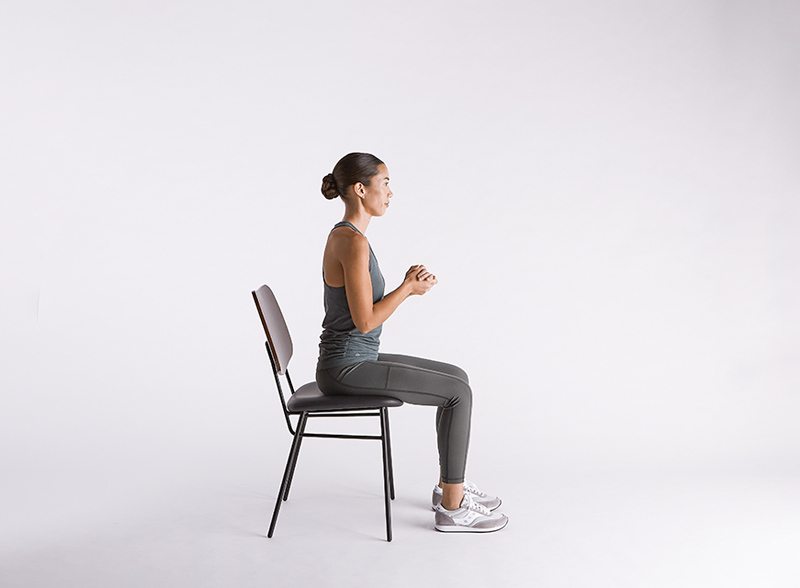How to Do a Sit to Stand Exercise: A Hinge Health Guide
Learn how to do a sit to stand exercise to help with lower body strength and mobility, plus modifications to make it easier or harder.
- Hinge Health Learning Center
- Articles
- How to Do a Sit to Stand: A Hinge Health Guide
Table of Contents
Do you ever struggle to stand up from a seated position? Or lose your balance when going from sitting to standing? If so, the sit to stand exercise may be a good addition to your movement routine. This simple yet effective exercise helps to improve strength and mobility in your lower body, while improving balance, too.
Here, learn more about how a sit to stand exercise can benefit you, and how you can try it out at home.
Our Hinge Health Experts
Dylan Peterson, PT, DPT
What Is a Sit to Stand?
Also known as a chair rise or chair stand, the sit to stand exercise involves sitting down and standing up from a seat without using your hands for assistance. It helps to improve strength and balance in muscles that help you sit down and stand up. It’s also a great exercise for anyone recovering from a surgery that impacts mobility, such as a knee or hip replacement, or for anyone looking to increase core, thigh, hip, or glute strength.
What Muscles Does the Sit to Stand Work?
The sit to stand exercise helps to strengthen your core, which helps you maintain stability in everyday activities, such as walking, reaching for objects, or shifting your weight from one foot to another. The sit to stand also strengthens muscles in your thighs, hips, and butt, including:
Quadriceps: Located at the front of your thigh, these muscles are responsible for extending your knee. They play a crucial role when you're pushing yourself up to a standing position and controlling your descent back into a seated position.
Hamstrings: Located at the back of your thigh, these muscles work in tandem with your quadriceps to control the motion of sitting and standing. They help in bending the knee and extending the hip joint.
Gluteus maximus: This is the major butt muscle. It's primarily responsible for hip extension, a key motion when standing up from a seated position.
Erector spinae: These are the muscles that run along your spine and help you maintain an upright posture.
Calves (gastrocnemius and soleus): These muscles help in lifting your heels and stabilizing your ankles when you push off the ground to stand.
Sit to Stand Benefits
By strengthening your core, thighs, hips, and butt, you may notice many benefits, such as:
Improved ability to do everyday activities, such as sitting down, standing up, or climbing stairs without pain
Better balance (which can also help promote independence for some older adults)
Increased mobility, especially in the knees, hips, and ankles
Improved muscular endurance
Easier recovery from a hip or knee injury or surgery
Sit to Stand: Exercises and Modifications
The information contained in these videos is intended to be used for educational purposes only and does not constitute medical advice or treatment for any specific condition. Hinge Health is not your healthcare provider and is not responsible for any injury sustained or exacerbated by your use of or participation in these exercises. Please consult with your healthcare provider with any questions you may have about your medical condition or treatment.
Sit to Stand
Sit to Stand
Sit to Stand
Sit to Stand
Tap into pain relief. Anytime, anywhere with our app.
To do a sit to stand:
Sit in a chair with your feet apart while holding your hands together in front of your chest. (Make sure it’s a stable chair that is not on wheels.)
Without using your hands, push through your feet to stand and hold this position.
Bend your knees to sit into the chair with control.
Sit to Stand Modifications
Sit to Stand Modifications
Sit to Stand Modifications
Sit to Stand Modifications
To make sit to stand easier:
Add a cushion to your chair to raise the height.
Use a taller chair to raise the height.
To make sit to stand harder:
Use a chair with a lower seat height.
Sit down more slowly (which requires more muscular control).
You can apply one of the above modifications to make the exercise easier or harder, or multiple modifications at once.
How Hinge Health Can Help You
If you have joint or muscle pain that makes it hard to move, you can get the relief you’ve been looking for with Hinge Health’s online exercise therapy program.
The best part: You don’t have to leave your home because our program is digital. That means you can easily get the care you need through our app, when and where it works for you.
Through our program, you’ll have access to therapeutic exercises and stretches for your condition. Additionally, you’ll have a personal care team to guide, support, and tailor our program to you.
See if you qualify for Hinge Health and confirm free coverage through your employer or benefit plan here.
This article and its contents are provided for educational and informational purposes only and do not constitute medical advice or professional services specific to you or your medical condition.
Looking for pain relief? Check if your employer or health plan covers our program
References
Elsevier – Patient Education │ Sit-to-stand exercises. (2022, April 10). Elsevier.health. https://elsevier.health/en-US/preview/sit-to-stand-exercises
Kang, K.-Y. (2015). Effects of core muscle stability training on the weight distribution and stability of the elderly. Journal of Physical Therapy Science, 27(10), 3163–3165. doi:10.1589/jpts.27.3163
Chaovalit, S., Taylor, N. F., & Dodd, K. J. (2019). Sit-to-stand exercise programs improve sit-to-stand performance in people with physical impairments due to health conditions: a systematic review and meta-analysis. Disability and Rehabilitation, 42(9), 1–10. doi:10.1080/09638288.2018.1524518
